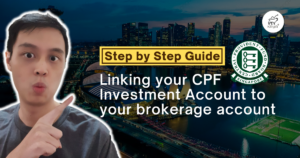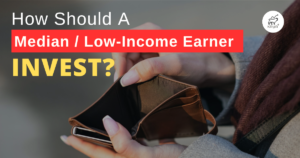How Should a Median-Income/Low-Income Earner Invest?

This post is long overdue after I promised an investing friend to come out with a rebuttal article.
What triggered this?
My friend got tired of the “Here’s how you should invest $100k, $1mil” kind of content going around in the personal finance space.
Sounds very flashy and clickbait. But when you think deeper, there aren’t that many people out there with that amount lying around.
And even if they do have, their banking relationship manager would be the first to jump in offering solutions and advice.
Pretty sure info and sources advising the median or average income earners on starting their investing journey are limited.
But before knowing the “how”, it’s best to start with the “what”.
What do you envision your investment returns to be?
Investment returns are straightforward.
It is inversely proportional to how passive you want it to be, or how much risk you want to take.
High risk, high return.
The more passive it is, the lesser the returns should be.
Nothing in this world is free. Should you want to outsource wealth planning and compounding, you need to pay someone to do it.
If you are risk aversive, then you should not be expecting a return of high double digits let alone 20% per annum.
The stock market is a very efficient tool for preserving and growing wealth. And the great thing is, whatever you want it to be, it shall be.
If you treat it as a casino, you shall get casino-esque returns.
If you treat it as just a space that provides one-off returns once in a blue moon, so shall it be.
Can the long-term rate of return give you the retirement life you want?
So let’s say you decided to opt for index fund investing, via SPY or VOO.
With a long-term return rate of 9%, you are likely to compound your wealth at that rate for the next 20-30 years.
Say you can put in $500 a month, a total of $6,000 a year consistently. What would your returns be should you start investing at the age of 30, for the next 30 years?

Turns out you can almost achieve $1mil by doing so. Note that this is just a simple statistical projection, which does not include market crashes and volatility.
If having $980k by the age of 60 is a goal you are happy with, investing passively is an option.
However, what if you can only fork out $3,000 per annum? What would your compounded wealth be like by the age of 60?

Turns out that by just doing $3,000 per annum, you’ll end up with just below half a million by the age of 60.
If you are content with that, you can still opt for passive index investing.
But what if you wanted more?
You either need to top up your invested capital, or opt for investments that provide higher returns.
It’s just basic maths and statistics.
And let’s not also forget that inflation would mean that the $1 million 30 years down the road, would have lesser purchasing power versus today.
Chasing for alpha if you are not blessed with a high-paying job yet still want a great retirement life
The bitter truth, if you ask me, is that there is an impending need for the median-income earners to double down on taking higher risks by managing their investments.
Not everyone shares the same burden or predicament. Hence, not everyone can have the same savings or diligence to invest $6,000 every year without fail until they reach 60 years old.
You can argue that a higher risk does not necessarily translate to better returns if he or she does not know what they are doing.
They might not even have the time, effort or passion to analyze and make investing decisions.
Thus, there isn’t any alternatives other than to opt for a less lavish or more manageable retirement life.
Sounds capitalistic but it is what it is.
It is possible to boost your annual returns
Opting for higher risk and rewards does not always translate to the need for stock picking.

The Invesco QQQ Trust, has a 10-year track record return of 18.6%. Due to cyclicity and the volatility, let’s just take the 3-year 12% per annum to extrapolate the 30-year returns with an annual capital top up of $3,000

Voila, with 12% annual returns, it is possible to hit $911k in 30 years, with an annual top up of $3,000 instead of $6,000.
So the less capital you are willing to put in to invest, yet if you want a stretched end amount to retire, you have no choice but to take on more risks.
The Inflection Point of pivoting into active stock picking
To put things into perspective, assuming the end goal is to have $1 million by the age of 60 for a 30-year horizon, if one can only contribute $2,000 a year, they would have to achieve a higher rate of return, where the realms of passive investing might not be able to provide such returns to statistically reach the end goal.
This is where I would say the inflection point is, which is to take on active stock picking and DIY investing.
Tracking your annual progress
I am a firm believer in tracking progress. If something can’t be measured or tracked, you will have zero clue whether you will be achieving your end goals or not.
Once you have a desired end goal, split up the progress tracker to an annual basis, and record your year end NAV and see whether have you achieved your annual targets as the years go by.
If yes, good for you! Things are on track. If no, you might need to reconsider your investing vehicle or realign your end goals against what is achievable.
What if with 20% returns per annum, you still cannot achieve your end goal retirement sum?
I think should that be the case, you would be categorised under the lower-earning income group.
Your annual capacity to top up your investment account with a long-term return rate of 20% would still not compound you to a stage of say, $1 million.
So rather than opting for something ludicrous yet unsustainable in the realms of 30% per annum and above, I think it is more practical to upskill and to qualify for a better-paying job.
I am not saying it is impossible to find a 30% return investment, but it is quite impossible to do it consistently every year for the next 30 years.
This ties back to my previous substack where it focuses on how a good paying job compliments investment returns over a long horizon.
MyKayaPlus Verdict
I think it is important to plan for a life that you want, and when you want it.
If you want to retire earlier than the age of 60, you have lesser time to compound, and that also means higher annual contribution and higher annual returns is required to bring you to where you want to be.
I think going through an age curve (35-54 years old), where people tend to be at their most stressed out and unhappy period, can be crippling and demotivating.
There isn’t really a way out – it is part and parcel of life.
But since it is possible to attain happiness when we slowly edge towards retirement, I guess its worthwhile to work on it when we are at our prime.

I guess it’s better to have a quarter-life and mid-life crisis, rather than a retirement crisis.
Let me know your thoughts!






Who is the tired friend ?
Since you asked, the friend mentioned is you!
Credits to Vince @ reit-tirement.com for helping to manifest this article…